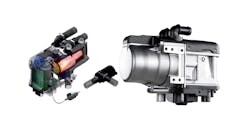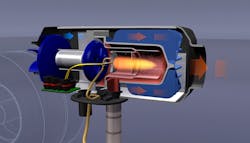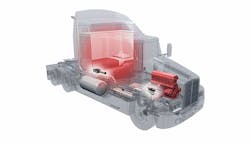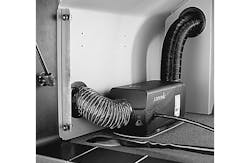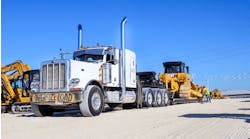Editor’s note: This is part three of a three-part series on readying fleets for harsh winter weather. Read Part 1 and Part 2.
On certain chilly mornings, it sometimes requires a Herculean effort to thrust off those toasty blankets and roll out of your warm cocoon-like bed to start the day. Maybe after a cup of coffee and hot shower, you can at least try to be a functional member of the workforce and you may feel ready to go after an hour or two.
Now consider what we expect semi-truck engines — which have been left out in sub-freezing temperatures — to do: start right up and power the transport of 40 tons uphill in the snow across the country (and your grandparents think they had it bad). While it’s true these engines weigh about the same as a polar bear, they are not as well equipped to shrug off an arctic atmosphere. Engines also need some time to warm up before they head off to work.
In the past, idling the truck was a common method to warm up the engine, though that expends on average about 0.8 gallons of fuel an hour, according to the Department of Energy. As fleets scour every opportunity to cut costs, it’s counterproductive to run an engine yet not go anywhere. But wasting fuel is just the obvious reason. It gets much worse.
“A lot of wear and tear goes into idling up to 155°F or 185°F, depending on the engine,” explained Tommy Smith, a regional sales manager at Webasto. The American Trucking Associations equates an hour of idling every day to 64,000 miles of engine wear annually.
And the colder the engine is, the longer it takes to get to that temperature, causing more stress on sensitive engine components. The way around idling or cold starts is using an engine preheater.
Engine preheating
There are many on the market, and at the 2019 North American Commercial Vehicle Show, Smith was showing off Webasto’s new Thermo Top Evo, powered by diesel taken directly from the tank. The compact 4.6-lb. heater is 8.54 x 3.58 x 5.79 in. and has a heating flow range of 8,600 to 17,200 Btu/hr.
Using the SmarTemp Control fx 2.0, a driver or manager can program the engine to start up to two hours before heading out, which Smith said could equal extra time in that warm bed.
The Thermo Top Evo comes with a longer fuel line and universal controller harness and mounting bracket. Being able to operate at a higher maximum combustion air temperature means it can be placed in a greater number of spots near the engine.
Whatever engine preheater a fleet goes with, they should keep in mind to factor engine maintenance into their calculations. Getting that engine up to the correct temperature when oil is more viscous and fuel is required causes strain on the diesel particulate filter (DPF).
“When you start the engine at 40° F, you’re going to push about 66% more particulate matter into the DPF than it’s designed to take,” Smith said.
He also added that more carbon dioxide and nitrogen oxide is being pushed into the atmosphere.
DPFs themselves cost several thousand dollars, last 100,000 miles, and take 60-90 minutes to service.
This advice extends beyond a cold snap up north. Even on a spring Georgia morning, Smith said the preheater has value: “Even if it’s 75° F in the morning, you need to get it up to 155°F.”
Bunk heating
For truckers who roll right out of bed and into the driver’s seat, their biggest concern is keeping the sleeper cab warm. That too can be done by idling while the cab heat is on, but that is extremely inefficient and costly.
Like the engine heaters, parking heaters, or bunk heaters, also run off the diesel line and use a fraction of what idling does. For instance, Webasto’s quiet running Air Top 2000 STC uses one gallon of diesel per 22 hours. Idling could consume at least 17.6 gallons. The company, which produces around 1 million heaters per year, introduced the first fuel-operated air heater in 1935.
This type of heater, typically factory installed on sleepers and also available in the aftermarket, starts at around $1,000.
“We’re not the cheapest, but quality-wise, you don’t have to touch ours again and don’t have to clean screens,” Smith said.
Given early Dec. 2019 average U.S. diesel costs of $2.57, that is $0.11/hour spent for the bunk heater versus about $2/hour for idling. If you run it 50 hours a week, you save more than $90 over idling.
“The return on investment is dramatic, plus you keep your driver nice and warm,” Smith said.
The Air Top 2000 is CARB-approved and EPA SmartWay-verified.
Auxiliary power units also reduce idling, though Kyle Cousins, vice president of operations at Fleenor Brothers in Joplin, MO, is firmly in the bunk heater camp. His fleet of Kenworth trucks, which includes W900s, W990s, T660s, and T680s, relies on factory-installed Espar Airtonic D2 bunk heating units when applicable.
“We have used APU systems in the past that did not utilize Espar heaters and have noticed they do not have the same heating capacity typically as the Espar units, as well as a higher failure rate,” Cousins said.
Fleenor Brothers has used Espar heaters for at least a decade, and Cousins cited the comfort they provide drivers and idling reduction as contributing factors to the fleet’s strong uptime numbers.
Cousins said another key tactic to battling the cold is remembering to perform fluid line and ventilation maintenance.
“We try to make sure our technicians go through all the coolant lines and the HVAC system as a whole before winter arrives so that we are not caught flat-footed once winter sets in,” Cousins said.

